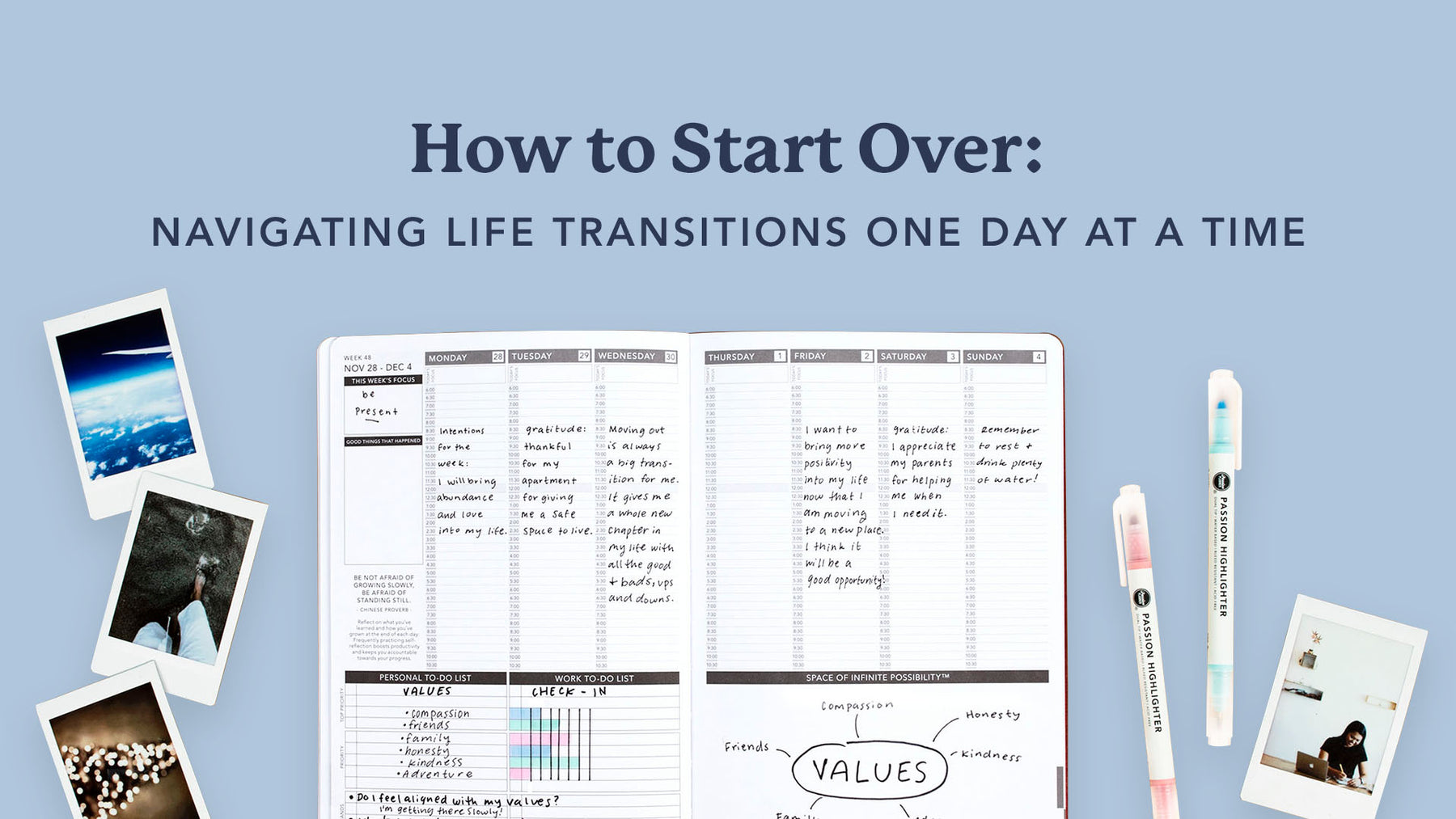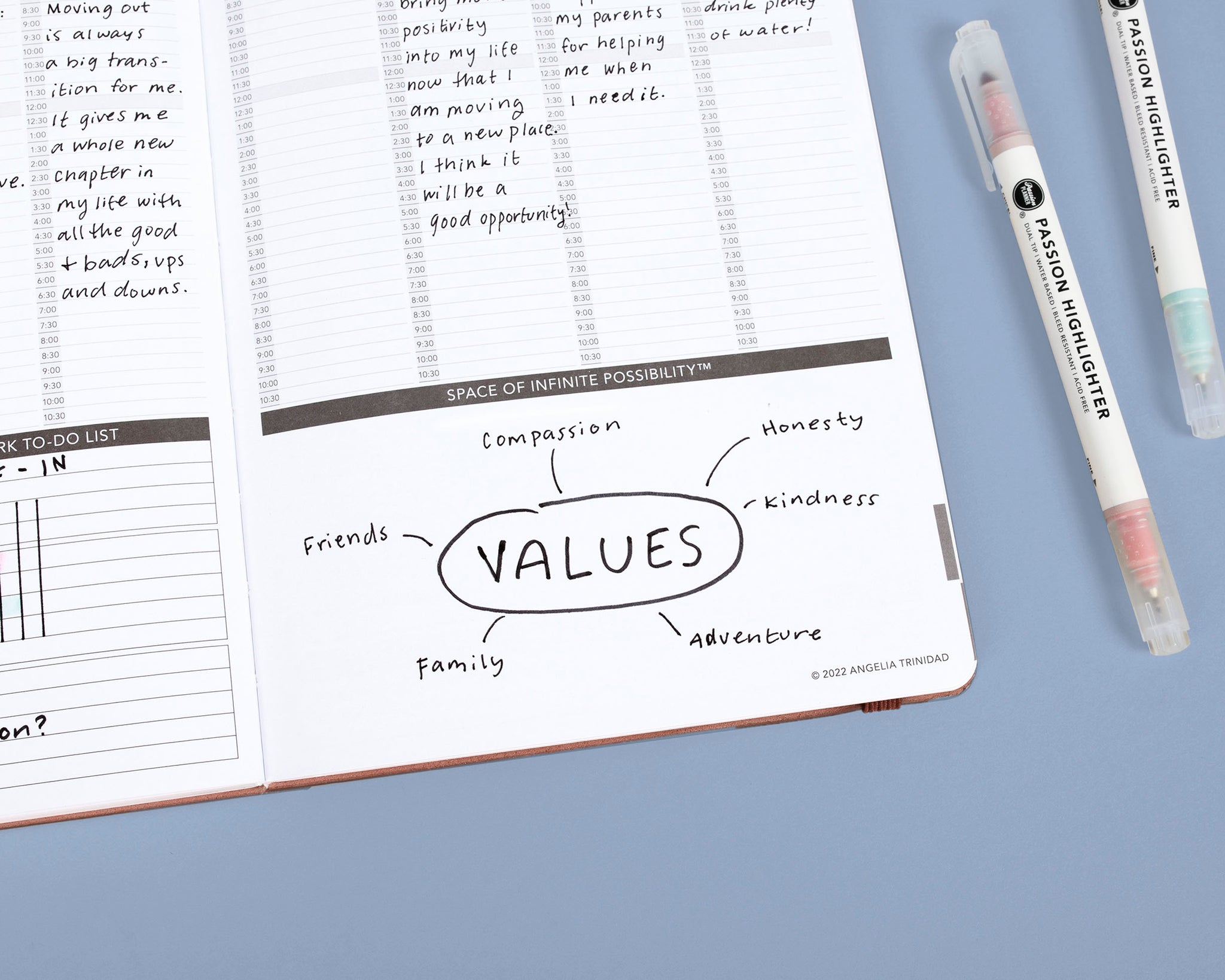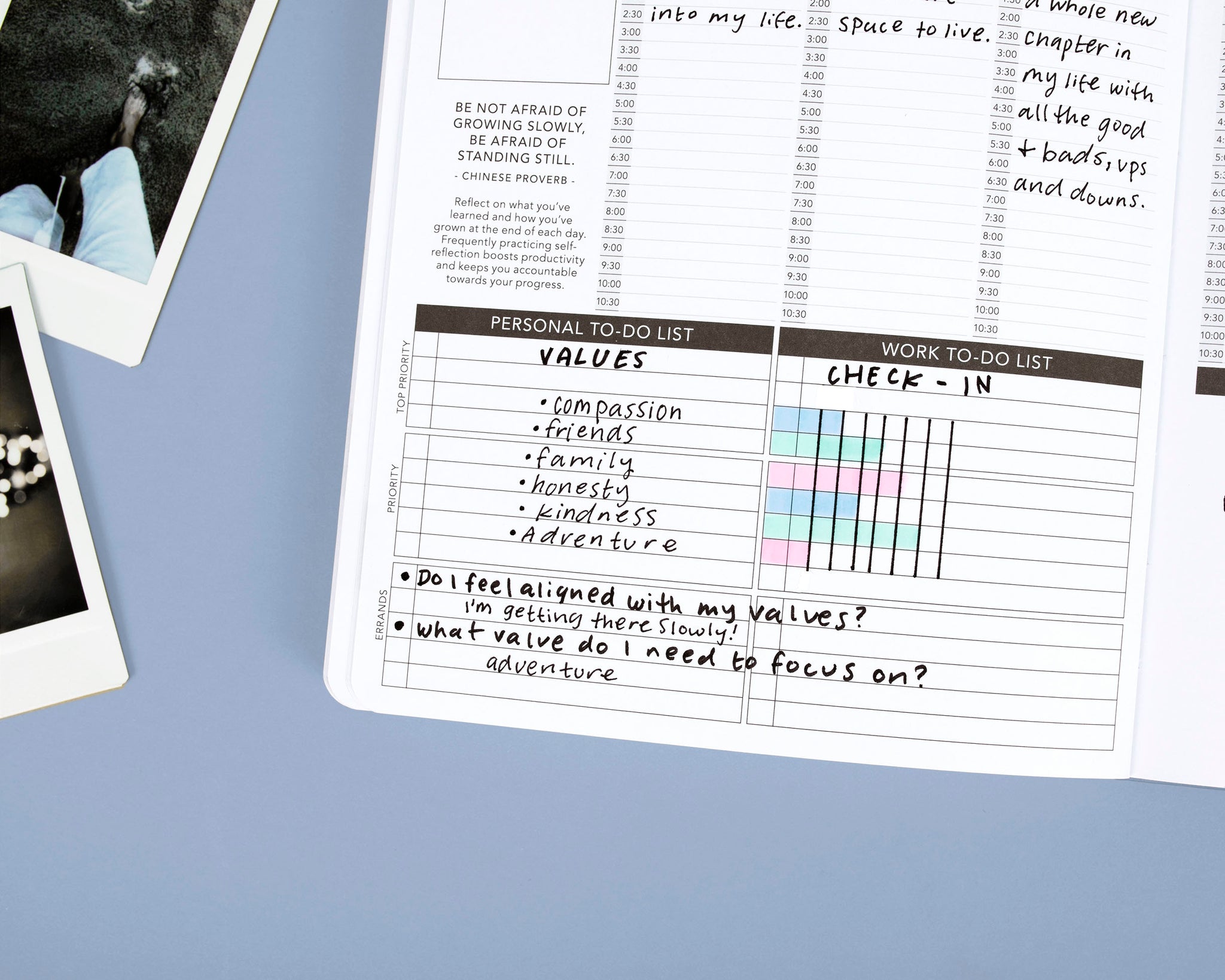
How to Start Over: Navigating Life Transitions One Day at a Time
Change can be hard, and sometimes even a little scary. Many of us (especially those in our #PashFam) prefer to plan things out far in advance, using the additional prep time to adjust to a new situation. But what happens when you get stuck and life just won’t give you that grace period? Today we’re talking about how to start over and use your Passion Planner to navigate big life transitions.
Stress and Your Brain
As a licensed therapist, I can tell you that there is a good reason why life transitions often translate into stress, even when the change is good: your brain can’t tell the difference.
Let me explain… I talk to clients often about resisting the urge to label emotions as ‘good’ or ‘bad.’ We need all of our emotions because each of them serves a purpose. Anger tells us that something has pushed our boundaries, anxiety tells us that we are experiencing fear. And stress indicates that we are going through a period of change.
Your brain’s main job is to keep your body systems functioning by sending messages to those other systems when it encounters a new stimulus. But because your brain has this one super-important job, it is sometimes a bit overzealous. In psychology, we talk about the difference between “eustress,” or stress that energizes or motivates change, versus “distress,” which can be overwhelming, distracting, and over time, damaging to your health.
Your brain responds to both eustress and distress the same way: releasing stress hormones into the bloodstream, and once you are safely away from the threat, taking other actions to return your body’s functioning to baseline. This is why you might feel energized as you run away, but totally exhausted when you get home. We call this managing your allostatic load, or how your nervous system manages the amount of stress you experience.
In short, change can be stressful because, well, it is stressful. Even when it’s "good" stress. Take this knowledge and know that it is okay to be kind to yourself as you navigate this transition. You’re doing the best that you can with what you have.
Change is the Only Constant
Just like I strongly discourage folks from assigning values to their emotions, I also really resist using the word “normal” to describe someone’s emotions. There is no one perfect response to experiencing a stressful event. It’s more important to know what is normal for you, to help you notice when something is off and give yourself what you need.
You may still be wondering what is normal during a life transition, or at the very least, what to expect. This is valid — just like we talked about above, your brain loves certainty. Knowing exactly what to expect is a lot less uncomfortable than venturing into new territory.
That said, the only constant in our lives is change itself. Think about when you were young, and every year of school, you changed grades, teachers, classrooms, and sometimes classmates, too. After a while, you got used to the rhythm of ending school every spring with one cohort and starting anew again every fall. For many people, starting middle school or high school meant a lot of this change all at once: multiple new teachers, a new school building, new classrooms. But within a few days or weeks, these changes began to feel like the new normal. This is an important reminder: you’ve adjusted to change before, and you can again.
So before we dive into how to navigate this big transition, or how to use your Passion Planner more effectively in doing so, take a deep breath, and give yourself permission to be a little “off” right now.
Finding the Value in Life
Change can come in many forms. Sometimes life forces you into a change before you’re ready, like a breakup, an unexpected health problem, or losing your job. These changes can be devastating, especially when they disrupt not just your life, but your goals and plans for the future as well. It can be frustrating and overwhelming to look at your Passion Roadmap (literally, or metaphorically!) and realize that you’re further away than you originally thought.
Other times, you’re in the driver’s seat, and can decide when and if making a change is right for you. So, how do you know when something isn’t working?
Whether the change was planned or unplanned, you can reframe it as an opportunity to get reacquainted with your values. Values are the things that are important to you, that help you make decisions and build a life you love. Values can include things like honesty, kindness, work/life balance, family, friendship, frugality, ease, joyfulness… just about anything that you can think of.

To get familiar with your values, take a minute with your Passion Planner. Find a blank spot with enough room to brainstorm — maybe your Space of Infinite Possibilities or in your Daily, the Room to Grow — and put the word “values” in the center. Next, set a timer for 60 seconds and branch out from there with any word that you would use to describe what is important to you.
It can be helpful to do this by looking back on how you spent your time in the last week or month, or looking ahead to see what plans you’re most excited about. Maybe you worked a lot of overtime last month and found yourself missing out on watching your niece’s soccer games, something that you always love. Or maybe you’ve had a lot more free time lately and have been enjoying the solitude and slower pace.

Once you have a sense of your values, it’s time to put them to work. It may be useful to make a list of which values show up in different areas of your life, and map out how close you are to living them. Think of this like a mindmap in the traditional Passion Planner style – write “home,” “work,” or “family” in the center, and branch off from there. Write your values closer to the middle if you feel close to them right now, and further away if they are harder to reach. Use this as a guide for your action steps next. You can also create a chart of your values and graph out how well you feel like you’re holding space for each value at this point in time. If you notice that “flexibility” is far away in your work mindmap or has a low bar on your graph, maybe it’s time to re-evaluate your work/life balance.
When a change happens unexpectedly, you may have to revisit your values to determine what to do next. For example, when you lose your job, it can be tempting to take any position that will have you just to make sure that you have a stable income. If you value financial stability highly, this may be the right move.
Your values can teach you when change is necessary, too. Let’s say you’re working that overnight job, but the only shift they have available is overnight. You value time with friends and family, and find that you are missing out on it more often than you would like. This might mean that the job can serve as a temporary stopgap until you find something that works with your financial needs as well as your schedule.
Know Thy Planner, Know Thyself
You might be thinking that wow, change and rebuilding yourself is a lot of work. And while you wouldn’t technically be wrong, that doesn’t mean that change can’t be worth the effort.
Because there is so much emotional work associated with making a life transition, your planner should be making that effort easier, not harder. Consider this your permission slip to completely start over if you need to. That’s right — if your layouts are getting clunky and cluttered, if your carefully-tended system has started to weigh down your days and actually makes it harder to keep track of everything you need to do, it’s perfectly OK to turn the page (literally and metaphorically).
If your schedule has changed dramatically, you might benefit from trying out a new layout, or recording multiple days on the same page of your Daily. Maybe stepping away from your current planning style and using your planner for something other than planning is actually what will be more supportive.
If you’re going through a difficult time emotionally or mentally, it can be helpful to use your planner as a space for reflection. Consider adding spaces for gratitude, self-care, journaling, or words of encouragement. The Passion Planner website can even get you started with some free quotes by BIPOC to paste in.

Or maybe you just have way too much on your plate, and need to keep it from getting jumbled. This is your reminder that you are under no obligation to make your planner pretty — minimalism gets the job done just fine. Yes, scrolling the #PashFam hashtag can make all of us a little jealous of other people’s perfect penmanship and cute stickers, but ultimately, your planner should work for your current life situation. If all you’ve got is one ballpoint pen and five minutes while you down your morning coffee, we’re ready to meet you where you’re at.
Building a Life You Love, One Day at a Time
We resist change because we crave stability. We love a sure bet, and the certainty that comes with knowing what to expect is soothing and gratifying. But life has a way of complicating those best-laid plans, and it’s OK to be gentle with yourself as you navigate what comes next.
Author Bio
Madeline Hodgman is a clinical social worker living in the Midwest with her husband and pets. In her free time, you can find her doing yoga, baking, reading, or exploring the national parks.

